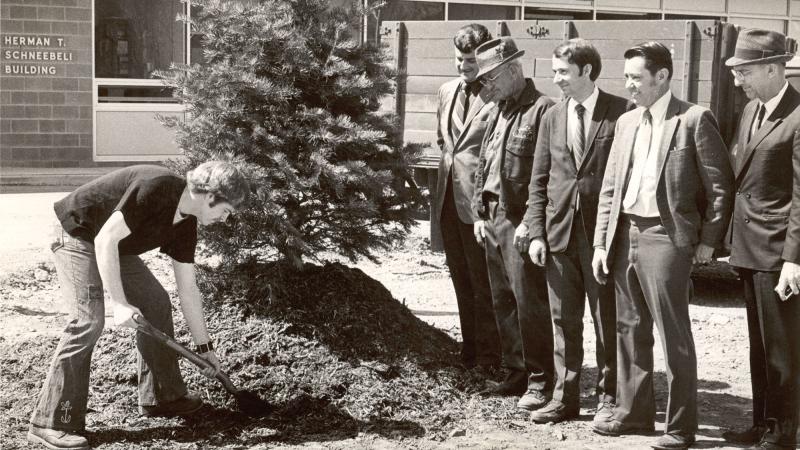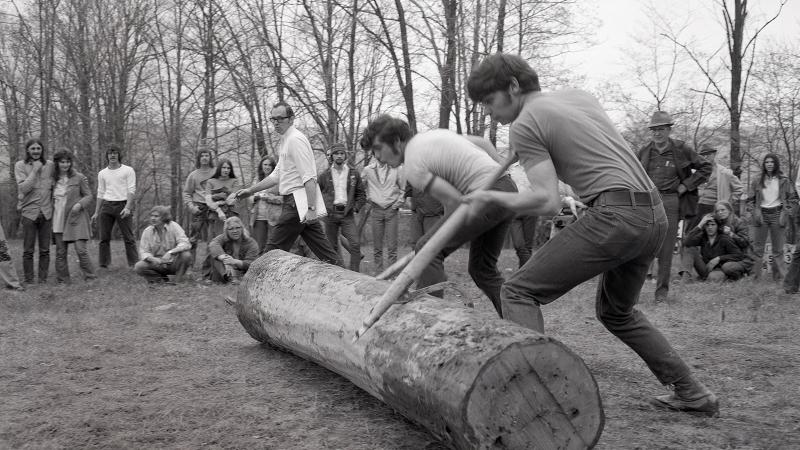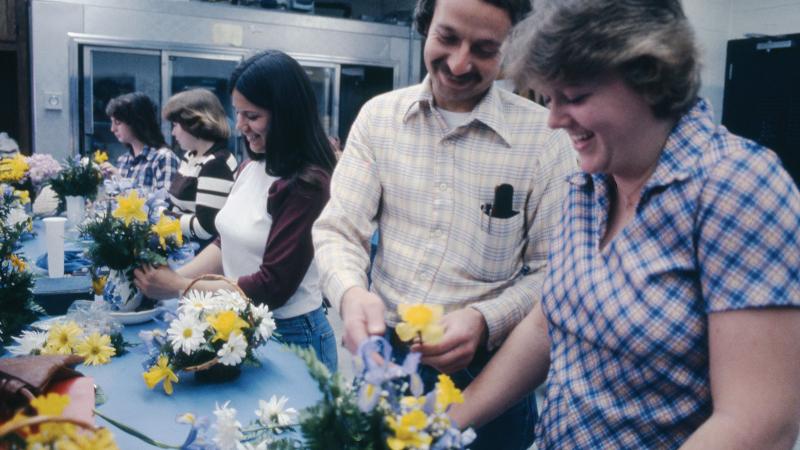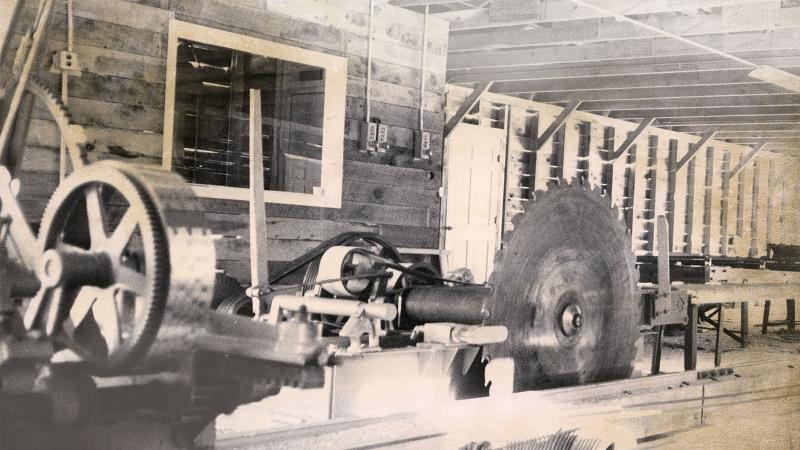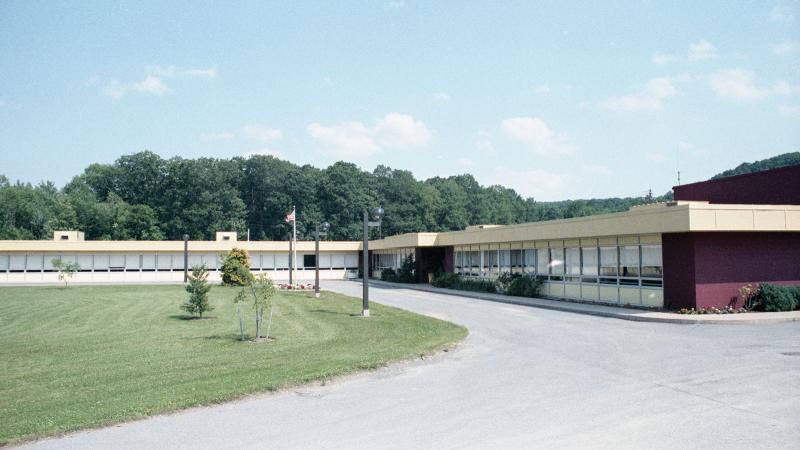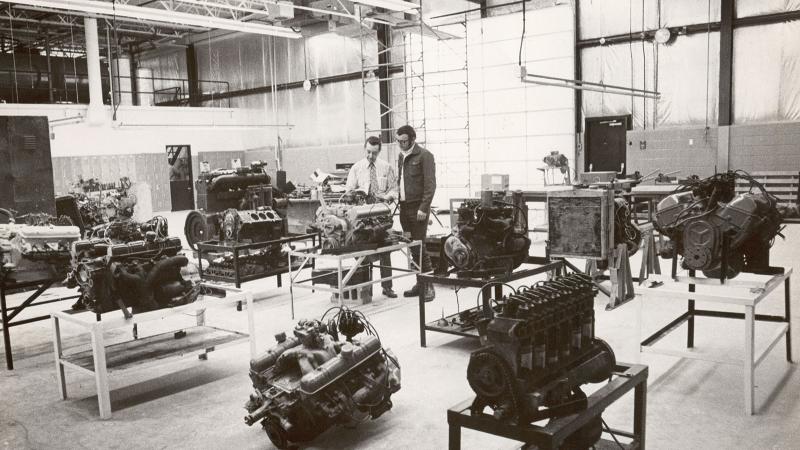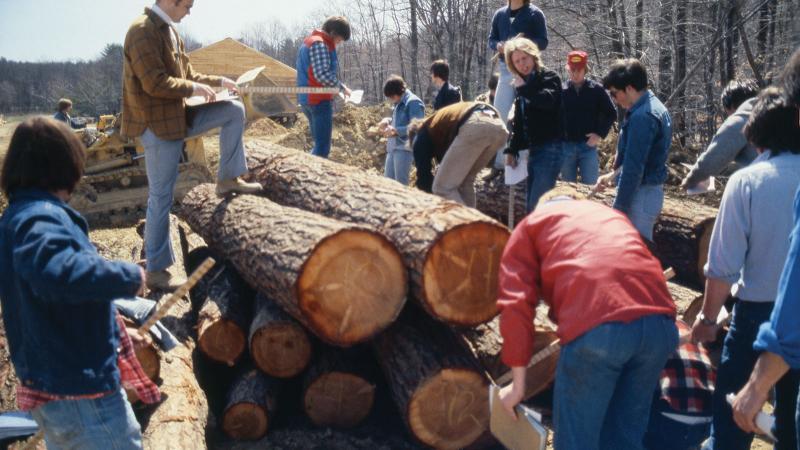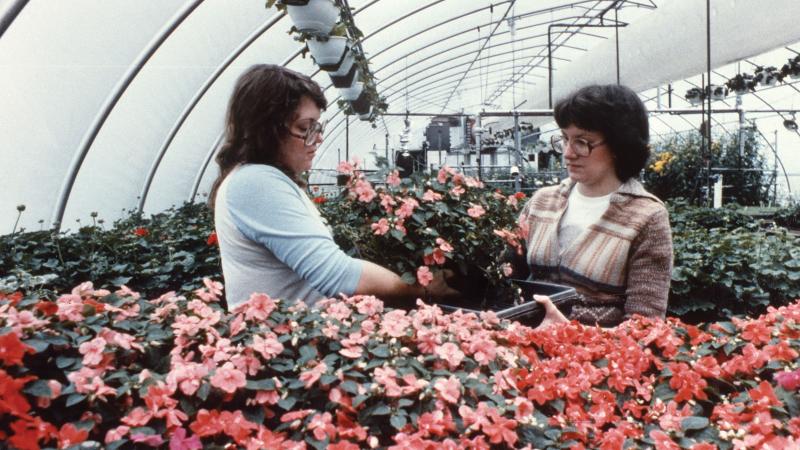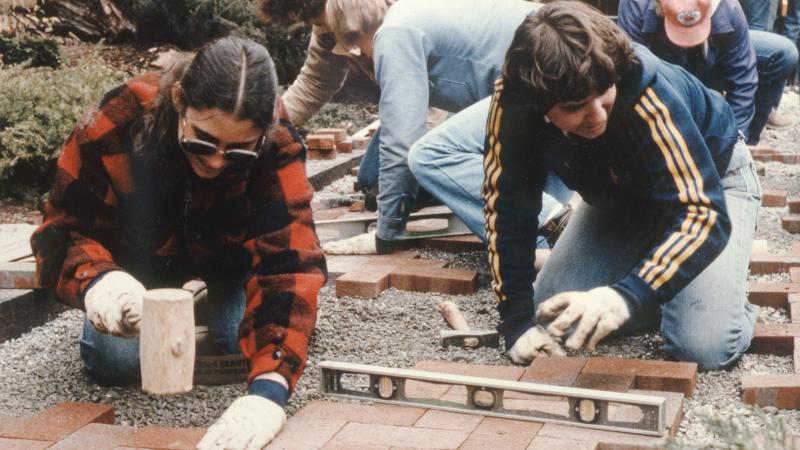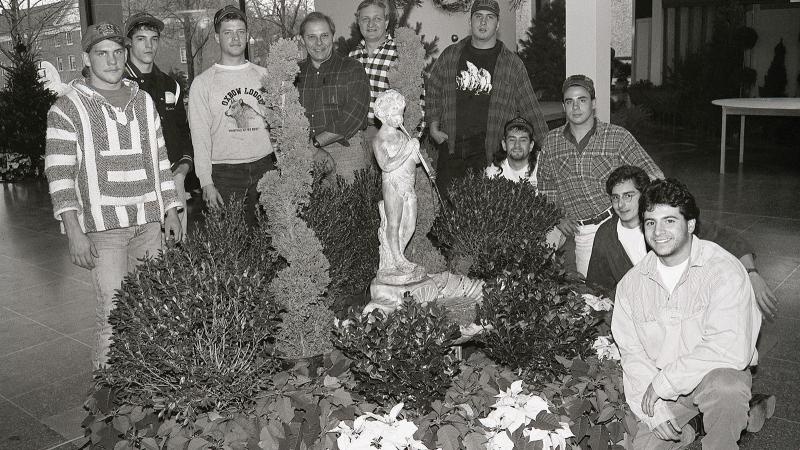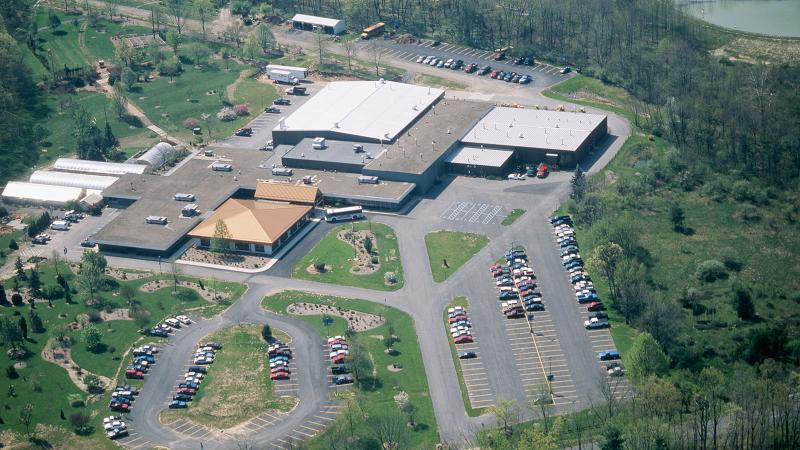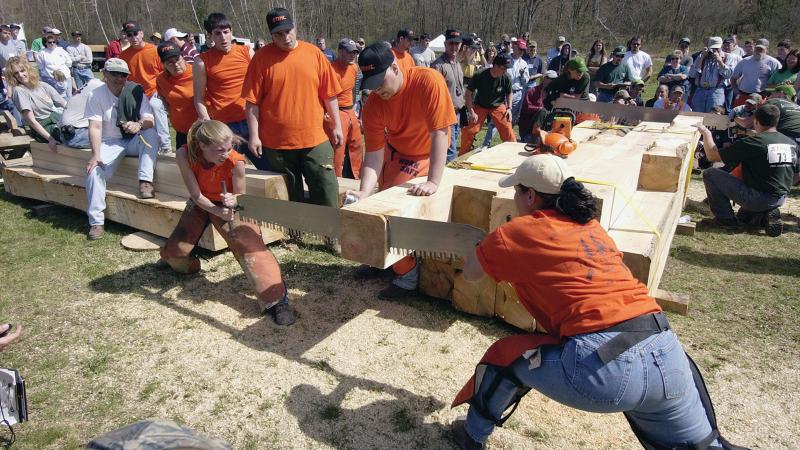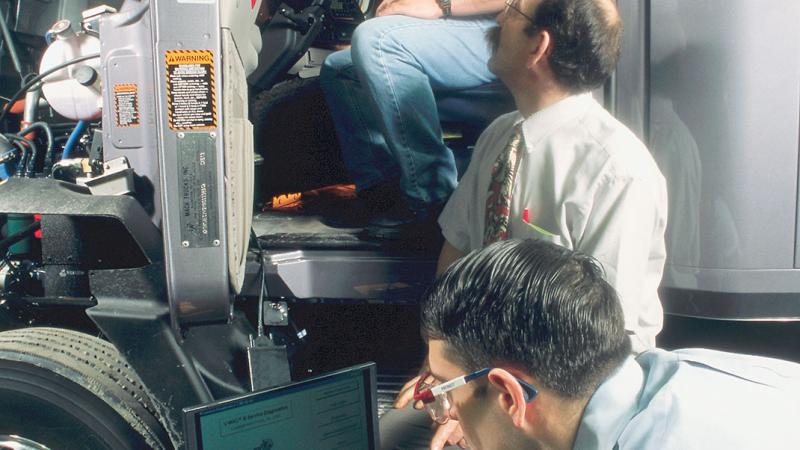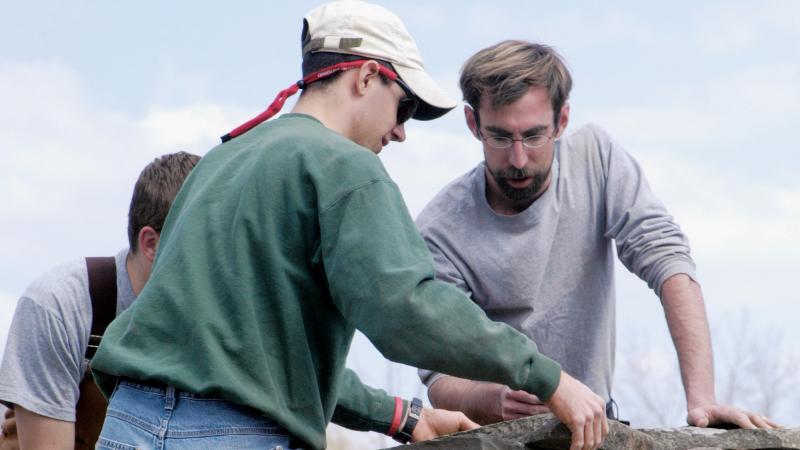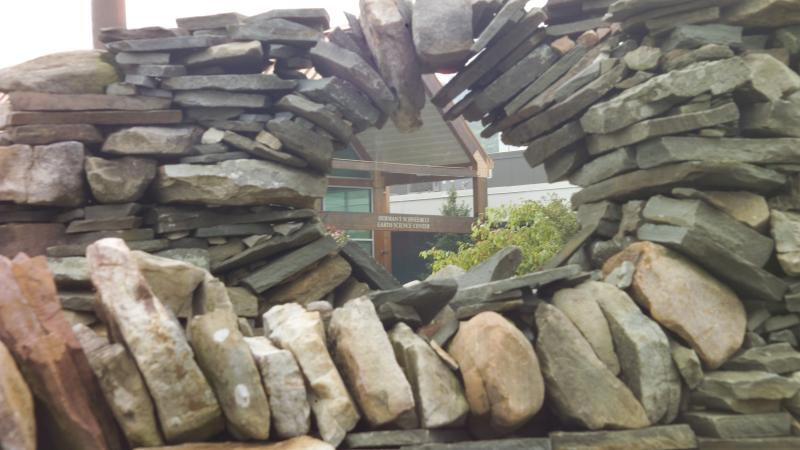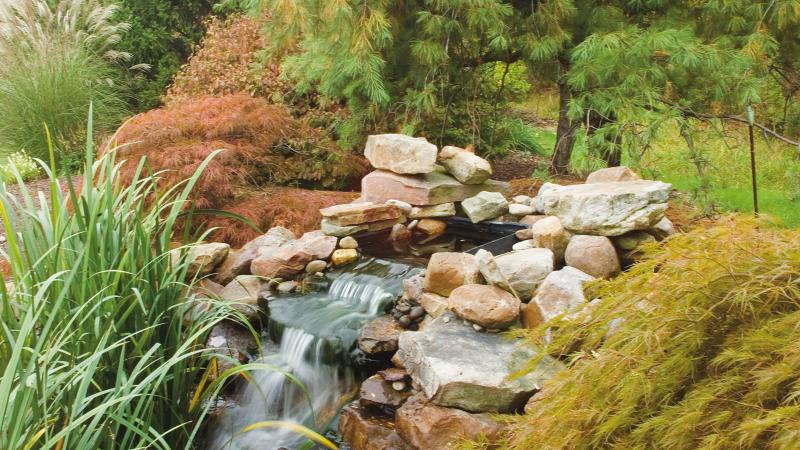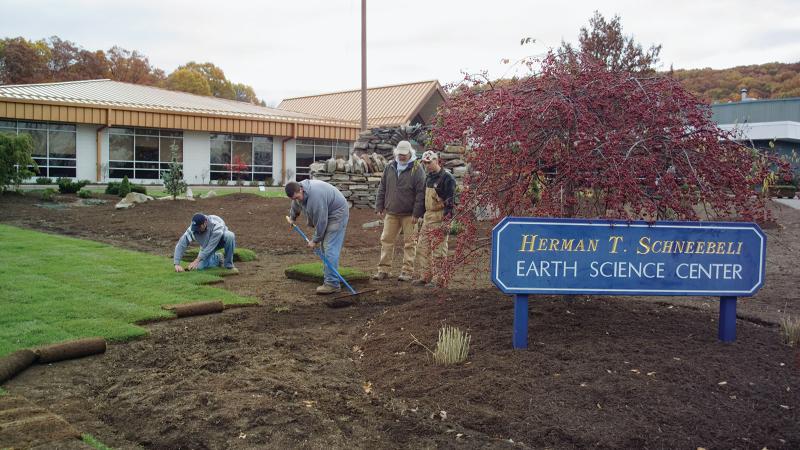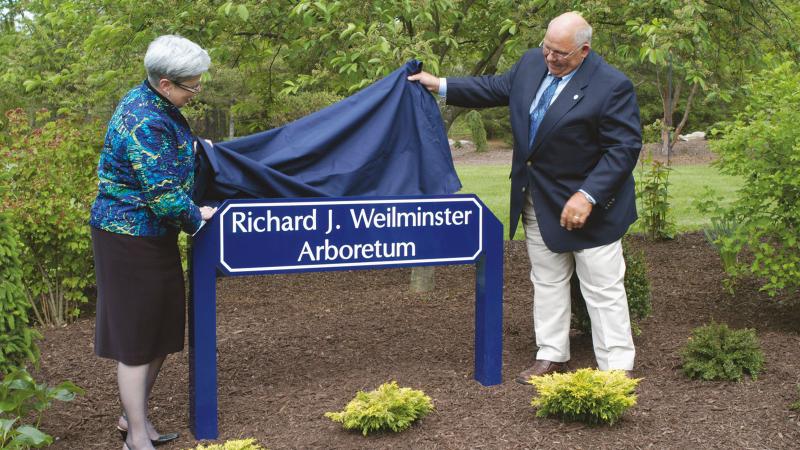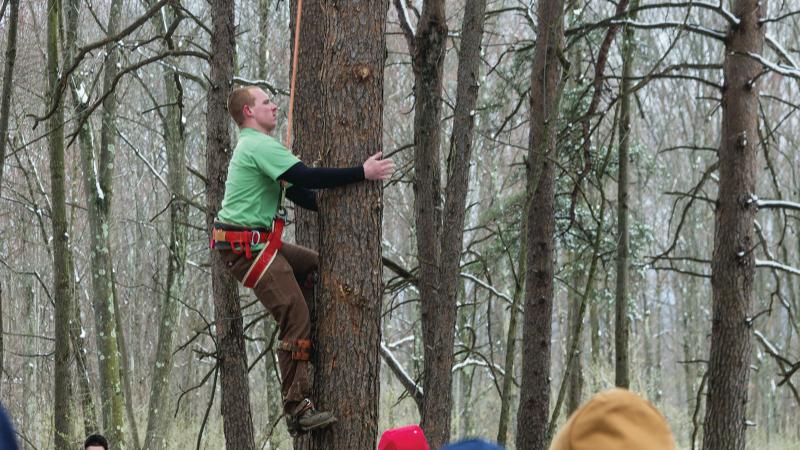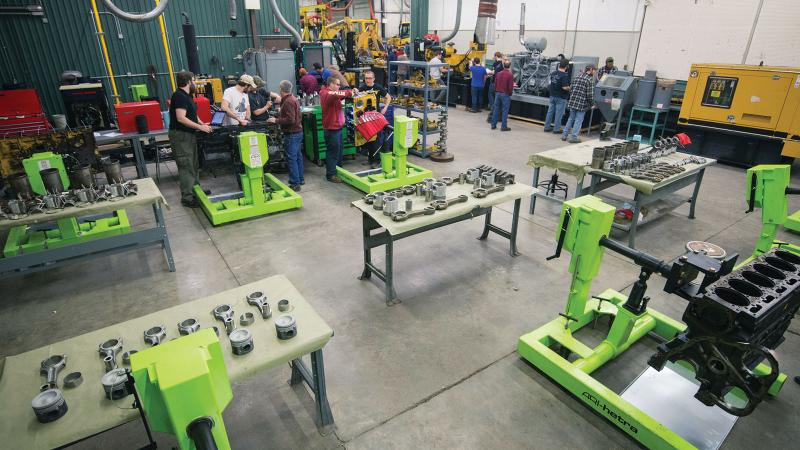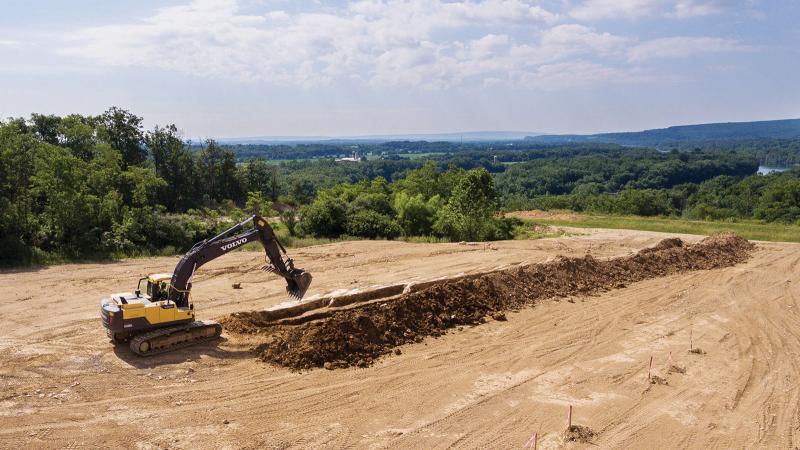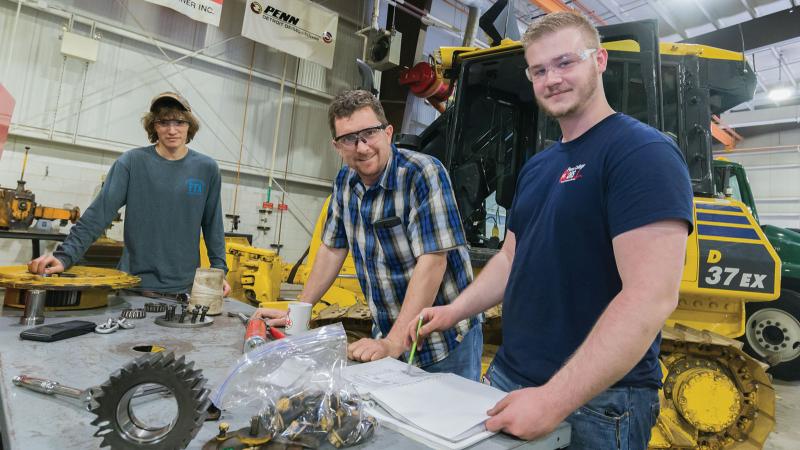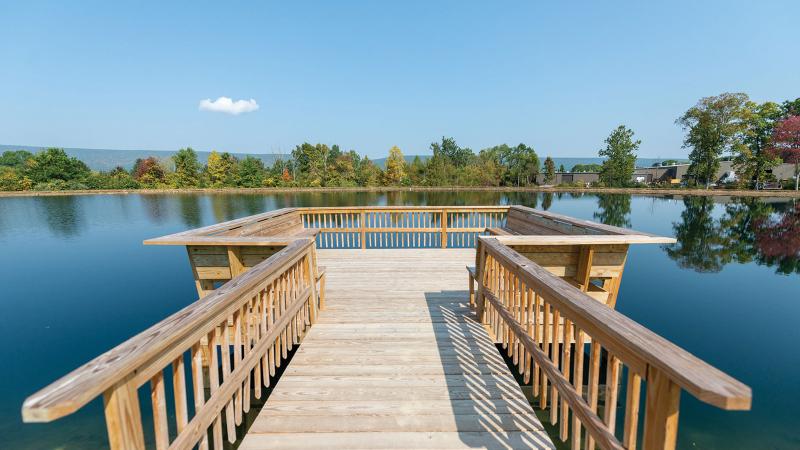2018: Forest technology students with instructor Eric C. Easton (left).
‘Living lab’ lives on after half-century
Published 08.27.2021
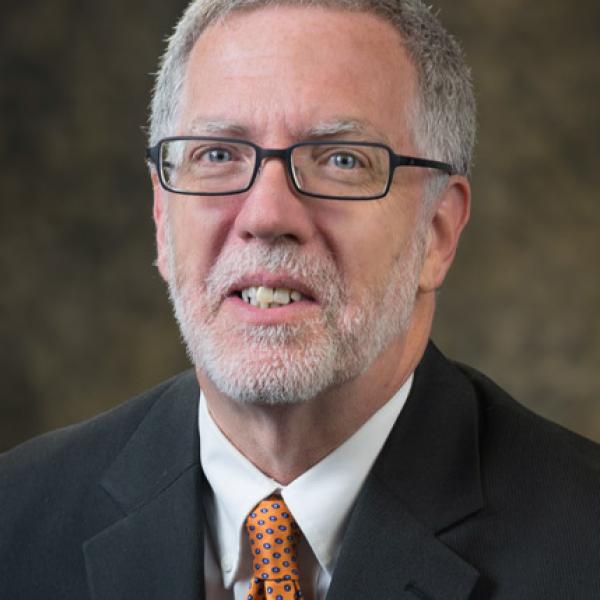
by Tom Wilson
Writer/Editor-Penn College News
“Also opening this year will be the Earth Science Facility near Allenwood, 10 miles south of Williamsport. Approximately 405 students of forestry, horticulture, agriculture and heavy equipment will study in this building. ... The structure is conveniently located near the college’s forest and farm lands for the benefit of students in the above courses.”
— Spotlight student newspaper, Sept. 7, 1971
That development, published in Williamsport Area Community College’s student newspaper, was among the first inklings of the wonders that awaited.
During the ensuing 50 years, WACC would become Pennsylvania College of Technology. The thriving campus would add a sawmill, and a riverside training ground for heavy equipment operators would open farther down Route 15. And five of the facility’s faculty members would receive the Veronica M. Muzic Master Teacher Award, the institution’s highest faculty honor.
It would also engender decades of fond memories for those who have called the paradisiacal campus “home.”
“When I think of my wonderful teaching years at the Earth Science Center, I immediately think of my boss at that time, Joe Sick, division director, and his secretary, Mabel Nevel. What a team!” said Glenn R. Spoerke, a forest technology faculty member who retired in 2007 as a curriculum specialist. “Their devotion and hard work together made it a great place.”
It was Joseph G. Sick and James P. Bressler (an instructor and later administrator) who teamed up to drive the programs’ move from main campus to the living laboratory over the mountain.
“Where are you going to teach it? You can’t teach it down there in the basement of a machine shop,” Sick related in a 2007 interview for the college’s oral history project. (Sick died in 2016.) “We had no labs, no greenhouse.” He said Bressler had “good rapport” with U.S. Rep. Herman T. Schneebeli, for whom the center has since been named, who arranged for the federal government to transfer excess prison land for educational use.
Among Sick’s early hires was Dennis F. Ringling, whose arrival in 1972 coincided with the fledgling national observance of Earth Day – a tradition he honored each year. Maintaining that his students should have sufficient command of their subject matter to impart it to others, he annually marshaled them to share their knowledge with area middle school pupils through interactive displays on the campus.
“I told students to give me ‘The Big 'E’ – not a letter grade – but ‘effort,’ the product of time, practice and patience.” He regularly stressed those values, along with safety, a must in a field that requires chain saws and tree-climbing.
Gerald Hoy, a 2002 forest technology graduate and today a forest resource planner for the Pennsylvania Department of Conservation and Natural Resources, recalls arriving early, as usual, for a 9 a.m. class taught by Ringling on Tuesday, Sept. 11, 2001. With carpool buddy Nick Nebzydoski, he encountered a group gathered around the cafeteria’s television and learned that a plane had just crashed into the World Trade Center. As they watched, a second plane hit.
“I remember hearing some yelling, crying and cursing,” Hoy said.
Forestry students were directed to a classroom, where Ringling was the first
to speak.
“The normally calm, cool and collected forestry lead instructor had more emotion and urgency in his voice than ever before,” Hoy recalled. “He said: ‘From this point forward, America has changed; our lives have changed.’”
Ringling encouraged students to check on their loved ones, to wait for the facts and to refrain from doing anything irrational. (Read Hoy’s full note.)
“I miss the students,” Ringling, the 2010 Master Teacher, said, proudly noting the “next generation of environmental stewards” represented by the thousands of graduates to whom he gave a head start. “And I miss walking in the woods four or five times a day. I still go outside quite a bit, but I do more ‘glamping’ than camping. I need hot water and a bed that’s semisoft!”
Richard J. Weilminster, the 1986 Master Teacher, came on board in August 1972, a year after the horticulture program was initiated by Wayne Ettinger, who had taught high school horticulture courses. At the time, there were only a few trees planted along the entrance drive to establish the arboretum, and the entire area was ungraded. (The arboretum added a conifer garden in 2006 and was named for Weilminster in 2008.)
“The two original horticulture programs were nursery management and floriculture. We eventually had to change the title of nursery management, as it was thought to be a day care curriculum,” Weilminster recalled.
“Most of the ESC faculty were young, dedicated and enthusiastic,” he said. “It was both good and bad being separated from main campus.” He said having space to establish the programs and hold outdoor labs was a boon, but getting to know counterparts on main campus was difficult. Sick was the campus’s driving force.
“It was always the most fantastic experience being a faculty member at ESC,” he said. “My career was enhanced by the opportunity to prepare and train students for an industry I love. When I retired in 2006, I felt very rewarded and fulfilled.”
An eventual colleague, who also became acquainted with the Earth Science Center in the 1970s, is Mary A. Sullivan.
“I first laid eyes on the Schneebeli Earth Science Center 45 years ago as a high school student visiting the campus in an attempt to find a place to start the next chapter of my academic life,” said Sullivan, who earned an associate degree in floriculture in 1979. “To say it was ‘love at first sight’ would be an understatement. The sprawling campus was beautiful, and I had a sense of this being a good fit for me.”
Two decades and four degrees later, Sullivan returned to the Earth Science Center, eventually becoming its dean. Many of the faculty were still there and very little had changed – including a unique culture.
“Faculty were either known by nicknames that made them sound like cartoon characters (Pivy, Doc, Weily and Bert) or simply by their last names,” she explained. “I soon realized the use of last names vs. first made perfect sense because, despite a small number of faculty, they all seemed to share only three or four first names!”
Campus directions didn’t involve hallways, staircases or other classroom buildings, she added, but were phrased as “past the sawmill at the top of the mountain near the cell tower,” “at the training site near the munitions bunker,” “beyond the plant prison” or “near the old ropes course at the pond.”
“It is thanks to Penn College and ‘the little campus over the mountain’ that I now get to spend my time doing what I love.”
“I’d often reflect about how lucky I was being at the Earth Science campus. For some, with hundreds of acres, it seemed isolating. But many of us welcomed the solitude. Where else could you walk for an hour, see snakes, fox, deer and even be chased by a bear, yet not see another human being?” Sullivan asked. “What other dean would come back from lunch, do a tick check and have to use a boot scraper (one at every door) to clean her shoes? None! Yup, I was lucky.”
Wildlife also linger in the mind’s eye of Deborah C. Books, who – impressed by the “earth” part of “Earth Science” – shared a number of photos over the years from her vantage as an administrative assistant.
“On my lunch walks, there were bees and butterflies and dragonflies, plops of frogs in the pond, and the scurrying of chipmunks,” she recalled. “Every spring, the flowers burst from the ground in vibrant colors, and every winter, the design labs were spicy with fresh greens. How could anyone not want to work there?
“And the students were excited to be an active part of learning. They got wet and cold, hot and dirty, and ’most always smiled, even when running into bees!”
Hired in a youth co-op in the late 1970s, horticulture student Kay Stackhouse-Stahl helped build a pole barn and groom the nature trails that wind through the woodland acreage. Her husband, Franklin P., a 1978 graduate in tool design technology (and brother to two other WACC alumni), was reminded of that experience when learning that the campus pond had been restored.
“We are happy to see that the area is being used and that, once again, students are involved,” he wrote. “As we have driven by on Route 15 so many times over the years, my wife would comment about her desire to check out the trails she was involved in. It was one of her favorite jobs of all times.”
Melissa (Berrier) Cramer, a 2008 graduate in landscape/nursery technology, is a landscape designer for Yonder Mountain Conservation Co. in State College; co-owner and creator of Big Valley Gardens with husband Nicholas B. (another 2008 alum); a professional Muay Thai boxer and a formidable lumberjill in logging competitions.
“It’s hard to place a value on the experiences I gained while at the Earth Science Center,” she said. “From the hands-on classes and plant collections that reinforced my love for the landscape industry, to the woodsmen’s competition that was a catalyst for my athletic endeavors, those years shaped my life in more ways than one.”
The most influential lesson came from assistant professor Dennis P. Skinner’s Plant Identification classes and had nothing to do with plants.
“It was to always walk with a sense of purpose,” she said. It paid to match his stride in class – whether to glean the tidbits he sometimes shared with those who kept up with him or to avoid being called out for lollygagging. “Today, that mantra continues to guide me when confidently walking onto a job site or into the ring.”
Student interaction with their environment is a hallmark for Carl J. Bower Jr., a landscape/nursery technology graduate who studied at Weilminster’s shoulder and now sits in his former office as an associate professor of horticulture.
“I have graduates ask me if I still take students out in Landscape Plants class in the snow, and the answer is yes,” he said.
He remembers Weilminster telling the class that, if he fell in the snow, they could laugh – as long as they got him back on his feet.
“I still tell students that on the first big snowfall,” Bower said. “Laugh all you want, but help me up!”
The 1993 graduate recalls his mentor cleaning out his workspace after 34 years, including the desk that would become Bower’s, and the surreal challenge of trying to fill a predecessor’s shoes.
“The day he left, or the day after, I sat there and just thought to myself, ‘I can’t believe I’m sitting here,’” he said. “I honestly don’t even know how long I sat there thinking that, but I can tell you I still feel as fortunate today as I did on that day.”
Karen R. Ruhl, part-time instructor of horticulture and the college’s 2021 Part-Time Teaching Excellence Award honoree, is likewise following a mentor’s footsteps.
Already a registered nurse, she enrolled in the floral design major in 2000.
“I was a part-time nurse, full-time mother of three and still loved the program,” she said.
She recalls creating artificial arrangements that were sold at Christmastime to college staff, helping with poinsettia placements at the Pennsylvania Farm Show and helping
“the real professionals” set up displays at the Philadelphia Flower Show.
“We even presented a Floral Design Show of our own,” she said, that included an invited professional designer.
“Dennis and Christine Fink were instrumental in this course, and through their mentorship, encouragement and enthusiasm, I learned that I could create beautiful things, and that I knew I someday wanted to teach this art.
“Little did I imagine that I would get the opportunity to do just that,” she said.
After filling in for a class or two in Fall 2013, she was asked to take over the floral design course in 2014, no longer a degree but an elective art course.
“It is thanks to Penn College and ‘the little campus over the mountain’ that I now get to spend my time doing what I love: showing students the beauty of flowers and giving them the opportunity to explore their own creative abilities.”
For many, the enduring perception of the Earth Science Center, then and now, is that it really is a family.
“Yes, it’s work. Yes, we are teaching. But I think most all of the faculty, staff and students would agree that it’s different over here,” Bower said. “Maybe because it’s a smaller building, or because there are not near as many students as on main campus, but the feeling here is more personal, almost an escape. We hear people describe it as, ‘Oh, you’re all the way over there,’ to which we reply, “Yes, and we like it over there!”
We were at the Earth Science Center the day America changed
by Gerald L. Hoy, ’02, forest technology
August 2001 was the start of my second year at Penn College. I was one of approximately 25 second-year forest technology students. I remember it was exciting to be back at the Earth Science Center. It promised to be a great year because much of the anxiety about college had subsided. We now knew our way around; we knew our instructors and what was expected of us. We were getting reacquainted with friends from our first year and really starting to grasp forest management concepts. Our second-year class consisted of mostly 19- or 20-year-old students, along with a few older and more experienced classmates. I was one of the young ones, at 19 years old.
Tuesday, Sept. 11, started off with my usual car pool from my Williamsport apartment to the Earth Science Center. Like most days, Nick Nebzydoski and I rode together. Among the carpoolers in the class, Nick and I were probably the most consistent companions.
As usual, we arrived early enough to hang out in the cafeteria for a few minutes before our 9 a.m. class with Dr. (Dennis) Ringling. As we entered the cafeteria area, we could immediately tell there was something different. A small group of 10 to 15 people were gathered around the TV on the cafeteria wall. We asked friends what was going on. They told us that an airplane had just crashed into the World Trade Center.
I’m somewhat ashamed to say that at the time, I didn’t know where the World Trade Center was. I didn’t even know what country it was in. I assume I wasn’t the only one who didn’t know. By attentively watching the news for the next 10 minutes, I quickly learned where it was and the magnitude of what had happened.
Our original group of 15 Earth Science Center students quickly grew to over 30. It became a mixed group of students, food service workers, custodial staff and several seasoned instructors on the brink of retirement.
Then the unthinkable happened: On live television, a second airplane crashed into the (World Trade Center’s) south tower. The reality of the situation was more apparent: The United States of America was under attack. I remember hearing some yelling, crying and cursing as we all tried to process what we had just witnessed.
The normally jovial forestry instructors were clearly shaken as they instructed the forestry students to report to a specific classroom. Even with all the wisdom most of us thought we had gathered in the first 19 years of our lives, we were confused and uncertain about what this meant. As we glued our eyes on him in disbelief, the first to address us was Dr. Ringling. The normally calm, cool and collected forestry lead instructor had more emotion and urgency in his voice than I’d heard before.
He said, “From this point forward, America has changed; our lives have changed.”
He went on to explain what the news was reporting and encouraged us to remain rational and wait for the facts. He also told us to call home to check on our loved ones. We spent the rest of class talking about what these attacks meant to the United States, what we could do to help, and what the future may bring.
After we were released from the classroom, a few of us went outside to talk. We were approached by a few students from another program. They were recruiting people to go to ground zero to help. Like them, I was feeling helpless and was fueled by emotions. At the time, this seemed like a logical thing to do. Our country had been attacked, and we were young, strong and able. With Dr. Ringling’s admonition to not do anything irrational and to wait on the facts fresh in my mind, I fought back emotions and made the rational decision to decline their offer.
I’m not sure what happened to those students. Did they drive halfway there and decide to go home? Did they make it to ground zero? Because they weren’t forest technology students and we didn’t see them the rest of the semester, I will probably never know.
About the author: Since graduating from Penn College’s forest technology program in 2002, Gerald Hoy has enjoyed a career in arboriculture, forest management and forest policy. He spent three years working for a small arboriculture company in State College and has spent the past 16 years working in a variety of positions with the Department of Conservation and Natural Resources, Bureau of Forestry. He has worked in the Bald Eagle, Loyalsock and William Penn forest districts. His current position is forest resource planner with the bureau. He and his wife, Melissa, also a Penn College graduate, live in Port Matilda with their four children: Lillian, Scarlet, Hazel and Porter. Hoy also serves on Penn College’s Forest Technology Advisory Committee and is an active advocate for Penn College within the forestry profession.

